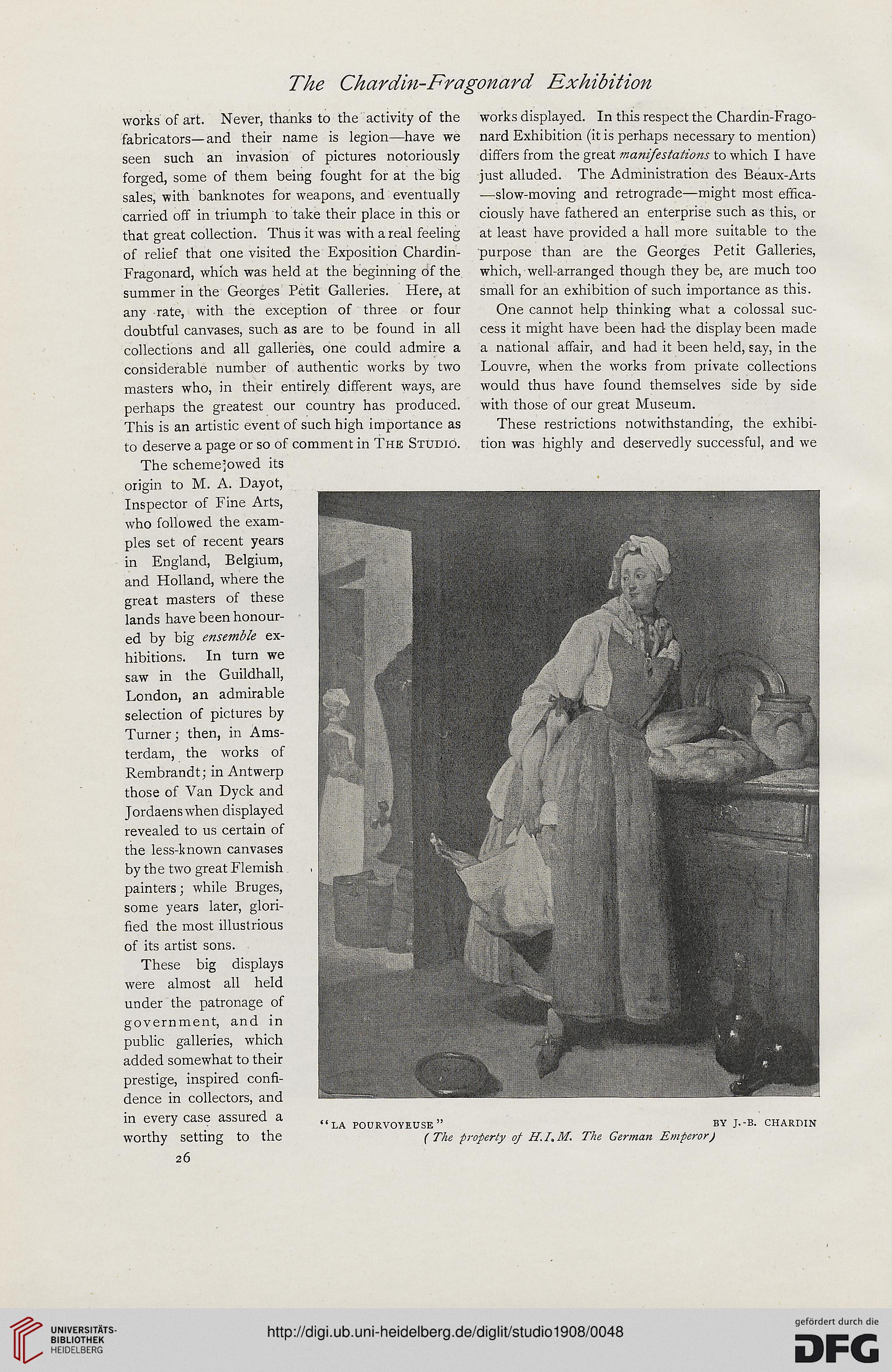The Chardin-Fragonard Exhibition
works of art. Never, thanks to the activity of the works displayed. In this respect the Chardin-Frago-
fabricators—and their name is legion—have we nard Exhibition (it is perhaps necessary to mention)
seen such an invasion of pictures notoriously differs from the great manifestations to which I have
forged, some of them being fought for at the big just alluded. The Administration des Beaux-Arts
sales, with banknotes for weapons, and eventually —slow-moving and retrograde—might most effica-
carried off in triumph to take their place in this or ciously have fathered an enterprise such as this, or
that great collection. Thus it was with a real feeling at least have provided a hall more suitable to the
of relief that one visited the Exposition Cbardin- purpose than are the Georges Petit Galleries,
Fragonard, which was held at the beginning of the which, well-arranged though tbey be, are much too
summer in the Georges Petit Galleries. Here, at small for an exhibition of such importance as this,
any rate, with the exception of three or four One cannot help thinking what a colossal suc-
doubtful canvases, such as are to be found in all cess it might have been had the display been made
collections and all galleries, one could admire a a national affair, and had it been held, say, in the
considerable number of authentic works by two Louvre, when the works from private collections
masters who, in their entirely different ways, are would thus have found themselves side by side
perhaps the greatest our country has produced, with those of our great Museum.
This is an artistic event of such high importance as These restrictions notwithstanding, the exhibi-
to deserve a page or so of comment in The Studio, tion was highly and deservedly successful, and we
The scheme-]owed its
origin to M. A. Dayot,
Inspector of Fine Arts,
who followed the exam-
ples set of recent years
in England, Belgium,
and Holland, where the
great masters of these
lands have been honour-
ed by big ensemble ex-
hibitions. In turn we
saw in the Guildhall,
London, an admirable
selection of pictures by
Turner; then, in Ams-
terdam, the works of
Rembrandt; in Antwerp
those of Van Dyck and
Jordaens when displayed
revealed to us certain of
the less-known canvases
by the two great Flemish
painters; while Bruges,
some years later, glori-
fied the most illustrious
of its artist sons.
These big displays
were almost all held
under the patronage of
government, and in
public galleries, which
added somewhat to their
prestige, inspired confi-
dence in collectors, and
in every case assured a
1 . LA POURVOYEUSE BY J.-B. CHARDIN
worthy setting to the (The property of H.I.M. The German Emperor)
26
works of art. Never, thanks to the activity of the works displayed. In this respect the Chardin-Frago-
fabricators—and their name is legion—have we nard Exhibition (it is perhaps necessary to mention)
seen such an invasion of pictures notoriously differs from the great manifestations to which I have
forged, some of them being fought for at the big just alluded. The Administration des Beaux-Arts
sales, with banknotes for weapons, and eventually —slow-moving and retrograde—might most effica-
carried off in triumph to take their place in this or ciously have fathered an enterprise such as this, or
that great collection. Thus it was with a real feeling at least have provided a hall more suitable to the
of relief that one visited the Exposition Cbardin- purpose than are the Georges Petit Galleries,
Fragonard, which was held at the beginning of the which, well-arranged though tbey be, are much too
summer in the Georges Petit Galleries. Here, at small for an exhibition of such importance as this,
any rate, with the exception of three or four One cannot help thinking what a colossal suc-
doubtful canvases, such as are to be found in all cess it might have been had the display been made
collections and all galleries, one could admire a a national affair, and had it been held, say, in the
considerable number of authentic works by two Louvre, when the works from private collections
masters who, in their entirely different ways, are would thus have found themselves side by side
perhaps the greatest our country has produced, with those of our great Museum.
This is an artistic event of such high importance as These restrictions notwithstanding, the exhibi-
to deserve a page or so of comment in The Studio, tion was highly and deservedly successful, and we
The scheme-]owed its
origin to M. A. Dayot,
Inspector of Fine Arts,
who followed the exam-
ples set of recent years
in England, Belgium,
and Holland, where the
great masters of these
lands have been honour-
ed by big ensemble ex-
hibitions. In turn we
saw in the Guildhall,
London, an admirable
selection of pictures by
Turner; then, in Ams-
terdam, the works of
Rembrandt; in Antwerp
those of Van Dyck and
Jordaens when displayed
revealed to us certain of
the less-known canvases
by the two great Flemish
painters; while Bruges,
some years later, glori-
fied the most illustrious
of its artist sons.
These big displays
were almost all held
under the patronage of
government, and in
public galleries, which
added somewhat to their
prestige, inspired confi-
dence in collectors, and
in every case assured a
1 . LA POURVOYEUSE BY J.-B. CHARDIN
worthy setting to the (The property of H.I.M. The German Emperor)
26




